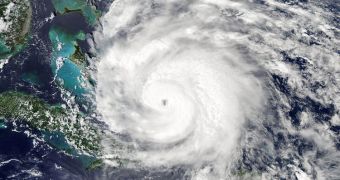Hurricane Irene, a Category 3 storm that struck North America in August 2011, is not an “100-year event,” as some experts have suggested. Rather than being an anomaly, a new study shows, it represents a clear indicator of how storm intensity will evolve as global warming progresses.
Investigators at the Princeton University and the Massachusetts Institute of Technology (MIT), in Cambridge, say that many more storms like Irene will batter the Gulf of Mexico, the western portions of the Atlantic, the United States, and portions of Canada, in the near future.
Hurricane Irene was the first storm to make landfall in the continental US since Hurricane Ike, in 2008. It caused massive floods, and battered affected areas with strong gusts of winds. It produced more than $10 billion in damages, and led to the death of 56 people.
The Category 3 storm was so intense that it produced high storm surges, which were able to move over seawalls. The water moved very fast, affecting inland communities just as strongly as seaside ones.
After the storm passed, some experts looked at the way it behaved, and determined that it must have been one of those rare storms that only happen once each century. Not so, says the MIT/Princeton group.
In a paper published in the latest issue of the top journal Nature Climate Change, the group warns that the frequency of Irene-like storms could increase to once every 3 to 20 years. At the same time, the incidence of 500-year floods could increase to once every 25 to 240 years.
Seawalls and related protective structures are an absolute necessity, says Ning Lin, a postdoctoral researcher at MIT, and the lead author of the new paper. Understanding how these storms act should provide authorities with some clue as to how tall and strong these barriers should be.
“When you design your buildings or dams or structures on the coast, you have to know how high your seawall has to be. You have to decide whether to build a seawall to prevent being flooded every 20 years,” the expert says.
The investigation, which took New York City as a case study, was led by Lin, the MIT Cecil and Ida Green Professor of Atmospheric Science, Kerry Emanuel, and Princeton investigators Eick Vanmarcke and Michael Oppenheimer.
Recurring, Category-3 storms would produce storm surges up to 2 meters (4.5 feet) high, which would easily topple Manhattan's 1.5-meter seawalls. 500-year storms could produce surges up to 3 meters (10 feet) high.
“The physical damage and economic loss that result from storm surge can be devastating to individuals, businesses, infrastructure and communities,” Louisiana State University Assistant Professor of Construction Management and Industrial Engineering, Carol Friedland, explains.
“For current coastal community planning and design projects, it is essential that the effects of climate change be included in storm-surge predictions,” the expert concludes.

 14 DAY TRIAL //
14 DAY TRIAL //